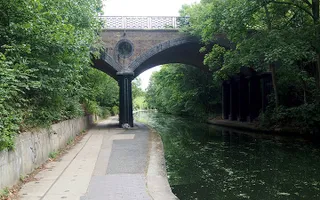What's in a name?
There are around 3,000 bridges along our waterways and each one has its own story. We explore the origins of their peculiar names.

Carrying the towpath across the canal basin in the shadow of the famous Camden Interchange Warehouse, ‘Dead Dog’ bridge on the Regent’s Canal, is the busiest canal footbridge in the country. Built in 1846, historically, the bridge had a notorious litter problem, as rubbish, carried along a 26-mile lock-free stretch of canal would accumulate in the tunnel below. Sadly, dead animals were often found among the debris, earning the bridge its grisly moniker.
Fiddler's Elbow Bridge
Built in 1915, ‘Fiddler’s Elbow’ bridge on the River Trent, near Newark, got its peculiar name thanks to the distinctive curve at the apex of its arch. Unique for its time, the bridge was constructed using the Hennebique system, a groundbreaking method of reinforcing concrete, still widely used today. With its unusual, elegant design, the Grade II Listed structure is a beloved local landmark and one of the most striking bridges on our network.
Whitsunday Pie Lock

On a quiet stretch of the Chesterfield Canal, near Retford, you’ll find the wonderfully named Whitsunday Pie Lock. According to local folklore, the lock earned its unusual moniker one Whitsunday, during the canal’s construction. Legend has it, that while navvies were toiling away on the lock, a woman from the nearby cottage served them some pie. To mark the event, every year, local residents gather at the lock on Whitsunday to enjoy a slice of pie.
Black Sabbath Bridge

A canal bridge in Birmingham was sprinkled with a little stardust, when it was renamed Black Sabbath Bridge, in honour of the city’s legendary heavy metal rockers. The road bridge, which crosses the canal on Broad Street, in the heart of Birmingham’s entertainment district, was christened at an event in 2019. Joining the celebrations, were original band members, Tony Iommi and Geezer Butler, who arrived aboard a narrowboat to unveil the new signage and commemorative bench.
Methodist Swing Bridge

It might look like an ordinary swing bridge, but Methodist Swing Bridge, on the Leeds & Liverpool Canal, was once at the centre of a deadly IRA plot, designed to spread panic and strike at the heart of UK infrastructure. In the early hours of July 27, 1939, three bombs were detonated across Liverpool, the first at Methodist Bridge. The explosion, reportedly heard three miles away, shattered the windows of nearby houses and left the bridge in ruins.
Double Arched Bridge

On the Leeds & Liverpool Canal, near Skipton in West Yorkshire, you’ll find the double arched bridge. As the name suggests, this striking piece of architecture is made up of two separate arches, with one stacked on top of the other. The original bridge was built around 1790, with the upper arch added later, to raise the level of the bridge to meet the new road. Today, this unique structure carries the A59 over the canal.
Blow Up Bridge

In 1874, Macclesfield Bridge in Regent’s Park made headlines when tragically a barge exploded directly beneath it, reducing the structure to rubble and killing all three men on board. The barge, named The Tilbury, was later found to be carrying a volatile cargo of gunpowder and petroleum, fatefully ignited when one of the boatmen lit a match. Rebuilt on its original cast-iron columns, the infamous structure would forever be known as ‘Blow Up’ bridge. Interestingly, when the cast iron columns were re-erected following the explosion, the end two were reversed so that the grooves historically worn by ropes are now found facing away from the canal.
These are just a few of the incredible stories behind some of our more unusual, historic bridges. Do you know of any local folklore surrounding the locks, bridges or buildings on a canal or river near you? Let us know by emailing [email protected].
Last Edited: 1 October 2025


Stay connected
Sign up to our newsletter and discover how we protect canals and help nature thrive

